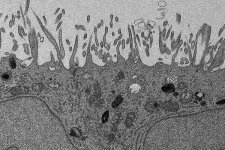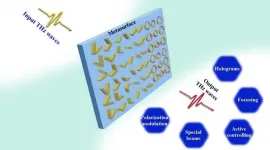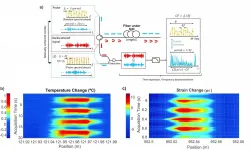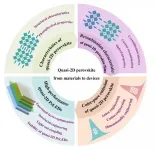Scientists reveal regenerative treatment path for diabetic foot ulcers
The approach also holds potential for repairing internal organs such as the heart, intestine and liver, which can become damaged by age and disease
2021-03-23
(Press-News.org) LA JOLLA, CA--A discovery involving multiple teams from across Scripps Research has revealed a powerful new approach for treating diabetic foot ulcers, which affect millions of people in the US and often lead to serious complications.
By targeting a gene that controls tissue growth and regeneration, the scientists were able to boost cell division at the site of injury and repair chronic wounds quickly. The new research appears in Nature Chemical Biology.
Given the growing prevalence of diabetes and limited options for treating foot ulcers--which can lead to amputation, in severe cases--it's clear that more effective treatments are needed, says chemist Michael Bollong, PhD, assistant professor at Scripps Research and senior author of the study.
"We developed a way to activate multiple aspects of wound healing using a small-molecule drug that can be applied topically, without affecting other tissues," Bollong says. "Essentially, we were able to trick the cells into proliferating and closing the wound, restoring the outer layers of skin."
Bollong's group worked in concert with laboratory of Scripps Research President and CEO Peter Schultz, PhD, and drug discovery teams at Calibr, which screened more than 800,000 molecules to find one that stimulated key regenerative pathways. The drug, PY-60, acts on a previously unknown regulator of tissue growth.
The researchers tested their approach in animal models and on "human skin equivalents," which are skin samples from people that are further cultivated in a petri dish. They hope to begin clinical trials within the next year.
Beyond treating chronic wounds, Bollong says the approach may lead to new regenerative therapies for heart disease, liver conditions and inflammatory bowel disease, or IBD. "We believe the future of this type of regenerative therapy is incredibly bright," Bollong says.
In the near term, however, the focus is diabetic foot ulcers, which affect roughly 15 percent of people with diabetes. More than half of those diagnosed with a diabetic foot ulcer will not survive the next five years, Bollong says, and the only existing regenerative therapy was developed more than two decades ago and has limited efficacy.
At the core of the new approach is a gene known as YAP, which is known to control organ size and tissue regeneration. YAP is regulated via a pathway called Hippo--often a target of cancer drugs due to its ability to influence cell growth.
Through their research, the scientists found a previously unknown player in the Hippo pathway--a protein that works with YAP to communicate cell density; when an organ or other tissue reaches a certain concentration, the cells will stop growing. But by targeting this protein with the new drug molecule, tissue cells bounce back into production mode. The healing process happens quickly and without producing negative side effects; in experiments, the outer skin layer doubled in a week.
"We found the results of the study to be incredibly compelling," Bollong says. "We hope this regenerative approach can eventually be added on to existing standards of care for diabetic foot ulcers."
INFORMATION:
The study, "YAP-dependent proliferation by a small molecule targeting annexin A2" was authored by Sophia Shalhout, Peng-Yu Yang, Edyta Grzelak, Kayla Nutsch, Sida Shao, Claudio Zambaldo, Jonathan Iaconelli, Lara Ibrahim, Caroline Stanton, Stormi Chadwick, Emily Chen, Michael DeRan, Sijia Li, Mitchell Hull, Xu Wu, Arnab Chatterjee, Weijun Shen, Fernando Camargo, Peter Schultz and Michael Bollong.
The research was supported by the Skaggs Institute for Chemical Biology and Calibr, the drug discovery and development division of Scripps Research.
[Attachments] See images for this press release:

ELSE PRESS RELEASES FROM THIS DATE:
2021-03-23
Metal-insulator transition (MIT) driven by many-body interactions is an important phenomenon in condensed matter physics. Exotic phases always emerge around the metal-insulator transition points where quantum fluctuations arise from a competition among spin, charge, orbital, and lattice degrees of freedom. Two-dimensional (2D) materials are a large class of materials. Their simple structure, low dimensionality, and highly tunable carrier density make them an ideal platform for exploring exotic phases. However, the many-body interactions are normally weak in most 2D materials, hence, the correlation-related phenomena ...
2021-03-23
Call it the evolutionary march of the penguins.
More than 50 million years ago, the lovable tuxedoed birds began leaving their avian relatives at the shoreline by waddling to the water's edge and taking a dive in the pursuit of seafood.
Webbed feet, flipper-like wings and unique feathers all helped penguins adapt to their underwater excursions. But new research from the University of Nebraska-Lincoln has shown that the evolution of diving is also in their blood, which optimized its capture and release of oxygen to ensure that penguins wouldn't waste their ...
2021-03-23
LA JOLLA, CA--An analysis of thousands of genomes from people with and without the rare eye disease known as MacTel has turned up more than a dozen gene variants that are likely causing the condition to develop and worsen for a significant share of patients.
The discovery, by a team of scientists from Scripps Research and the Lowy Medical Research Institute, in collaboration with Columbia University in New York and UC San Diego, provides a new avenue to pursue for diagnosis and treatment. It also sheds light on fundamental aspects of metabolism in the retina, a tissue with one of the highest energy demands in the human body. Findings appear today in the journal Nature Metabolism.
"It's exciting to uncover new answers to the ...
2021-03-23
The cost of the rechargeable lithium-ion batteries used for phones, laptops, and cars has fallen dramatically over the last three decades, and has been a major driver of the rapid growth of those technologies. But attempting to quantify that cost decline has produced ambiguous and conflicting results that have hampered attempts to project the technology's future or devise useful policies and research priorities.
Now, MIT researchers have carried out an exhaustive analysis of the studies that have looked at the decline in the prices these batteries, which are the dominant rechargeable ...
2021-03-23
Stuttgart - A team of scientists from the Max Planck Institute for Intelligent Systems (MPI-IS) in Germany, from Seoul National University in Korea and from the Harvard University in the US, successfully developed a predictive model and closed-loop controller of a soft robotic fish, designed to actively adjust its undulation amplitude to changing flow conditions and other external disturbances. Their work "Modeling and Control of a Soft Robotic Fish with Integrated Soft Sensing" was published in Wiley's Advanced Intelligent Systems journal, in a special issue on "Energy Storage and Delivery in Robotic Systems".
Each ...
2021-03-23
THz waves have a plethora of applications ranging from biomedical and medical examinations, imaging, environment monitoring, to wireless communications, because of the abundant spectral information, low photon energy, strong penetrability, and shorter wavelength. THz waves with technological advances not only determined by the high-efficiency sources and detectors but also decided by a variety of the high-quality THz components/functional devices. However, traditional THz devices should be thick enough to realize the desired wave-manipulating functions, hindering the development of THz integrated systems and applications. Although metamaterials have been ...
2021-03-23
Tailoring light is much like tailoring cloth, cutting and snipping to turn a bland fabric into one with some desired pattern. In the case of light, the tailoring is usually done in the spatial degrees of freedom, such as its amplitude and phase (the "pattern" of light), and its polarization, while the cutting and snipping might be control with spatial light modulators and the like. This burgeoning field is known as structured light, and is pushing the limits in what we can do with light, enabling us to see smaller, focus tighter, image with wider fields of view, probe with fewer photons, and to pack information ...
2021-03-23
Distributed optical fiber sensing (DOFS) is currently a mature technology that allows "transforming" a conventional fiber optic into a continuous array of individual sensors, which are distributed along its length. Between the panoply of techniques developed in the field of DOFS, those based on phase-sensitive optical time-domain reflectometry (ΦOTDR) have gained a great deal of attention, mainly due to their ability to measure strain and temperature perturbations in real time. These unique features, along with other advantages of distributed sensors (reduced weight, electromagnetic immunity ...
2021-03-23
Light-emitting diodes (LEDs) are changing the lighting and display industry and have obtained significant advances than traditional lighting sources. The traditional materials LEDs, e.g., III-V semiconductor LEDs, organic LEDs (OLEDs) and quantum-dot LEDs (QLEDs), have achieved great success and gradually realized commercialization, but still face some challenges. The OLEDs have the low carrier transport capability and exciton recombination, which would hinder the improvement of brightness. Besides, QLEDs show challenges for the tedious manufacturing process and the reliance on hydrophobic insulating long ligands also hinders their stability and electrical conductivity.
Compared with these traditional materials, quasi-2D ...
2021-03-23
A large proportion of dementia deaths in England and Wales may be due to socioeconomic deprivation, according to new research led by Queen Mary University of London.
The team also found that socioeconomic deprivation was associated with younger age at death with dementia, and poorer access to accurate diagnosis.
Dementia is the leading cause of death in England and Wales, even during the COVID pandemic, and is the only disease in the top ten causes of death without effective treatment.
The research, published in the Journal of Alzheimer's Disease, examines Office for National Statistics mortality data for England and Wales, and finds that in 2017, 14,837 excess dementia deaths were attributable to deprivation, equating to 21.5 per cent of all dementia deaths ...
LAST 30 PRESS RELEASES:
[Press-News.org] Scientists reveal regenerative treatment path for diabetic foot ulcers
The approach also holds potential for repairing internal organs such as the heart, intestine and liver, which can become damaged by age and disease








